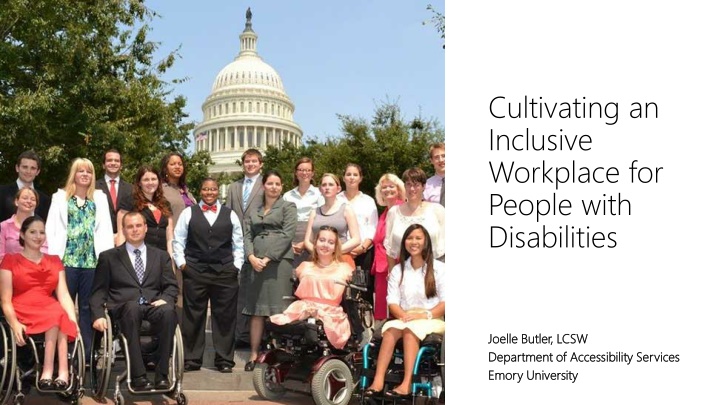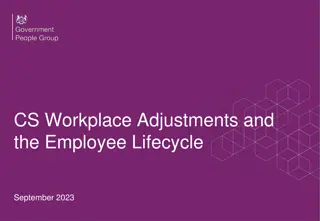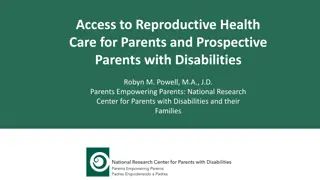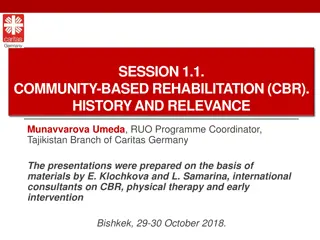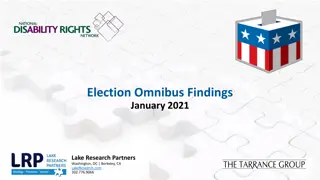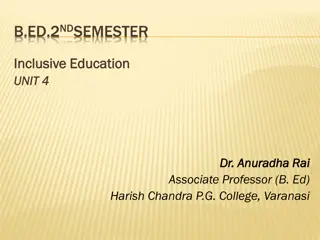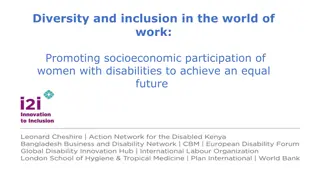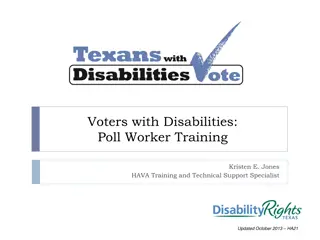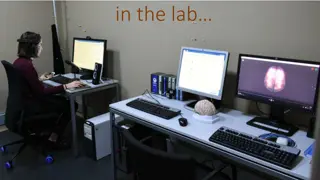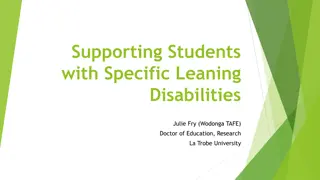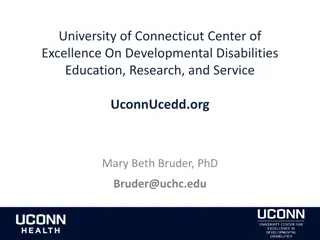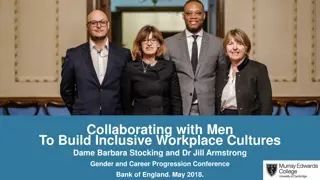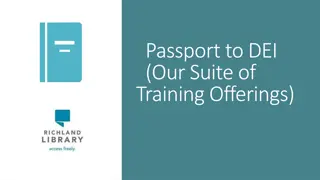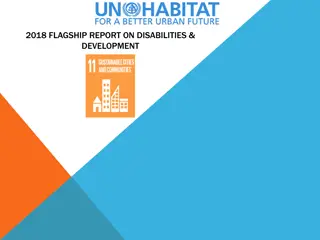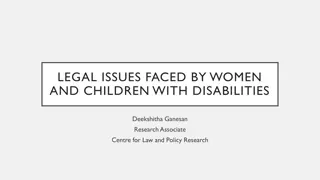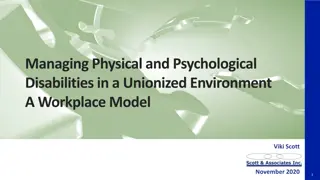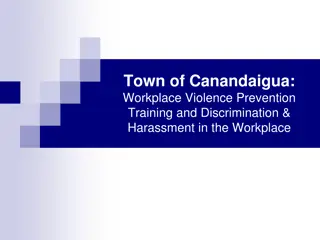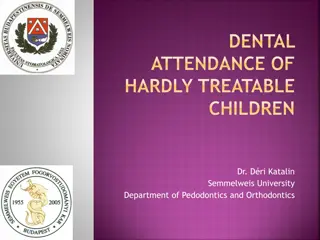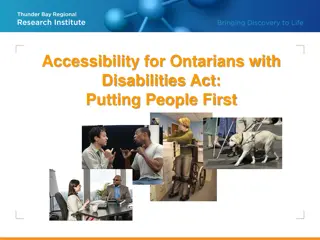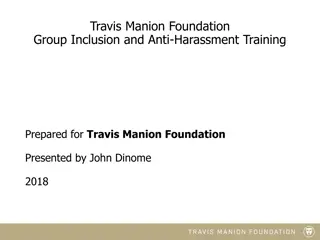Cultivating an Inclusive Workplace for People with Disabilities
In this insightful piece by Joelle Butler, LCSW from Emory University, the focus is on fostering an inclusive work environment for individuals with disabilities. Through practical strategies and empathy, the article navigates challenges and promotes understanding.
Uploaded on Feb 26, 2025 | 0 Views
Download Presentation

Please find below an Image/Link to download the presentation.
The content on the website is provided AS IS for your information and personal use only. It may not be sold, licensed, or shared on other websites without obtaining consent from the author.If you encounter any issues during the download, it is possible that the publisher has removed the file from their server.
You are allowed to download the files provided on this website for personal or commercial use, subject to the condition that they are used lawfully. All files are the property of their respective owners.
The content on the website is provided AS IS for your information and personal use only. It may not be sold, licensed, or shared on other websites without obtaining consent from the author.
E N D
Presentation Transcript
Cultivating an Inclusive Workplace for People with Disabilities Joelle Butler, LCSW Joelle Butler, LCSW Department of Accessibility Services Department of Accessibility Services Emory University Emory University Photo by Project Eye-To-Eye / CC BY 2.0
Overview FUTURE PRACTICAL STRATEGIES DISABILITY TRENDS BENEFITS OF DIVERSITY and INCLUSION CONSIDERATIONS
DISABILITY TRENDS
Disability is an ambiguous demographic, but one that is unambiguously increasing. Fujiura, Glenn T. Emerging trends in disability. Population Today. August/September, 2001
Largest Minority Group https://www.cdc.gov/ncbddd/disabilityandhealth/impacts/georgia.html Disability & Health U.S. State Profile Data for Georgia (Adults 18+ years of age)
Why has the population of adults with disabilities been increasing over time? Disability Redefined Increased awareness of the broadened definition of disability since the ADA Amendments Act of 2008 Improved Diagnostics and Treatments for people with non-obvious disabilities Aging Population Half of the Baby Boomers over 65 have a disability.
The Aging Population Baby Boomers (born 1946 and 1964) represent close to 75 million people in the U.S. 50% of Baby Boomers have been identified as having a disability. However, many don t self-identify as having a disability, despite significant age-related impairments. (Need for accommodations is underestimated) Baby Boomers choose to remain employed full-time far longer than the previous generation and remain a large percentage of the current workforce. A large percentage intend to age in place in their community. Baby Boomer customers control 80% of personal financial assets and over 50% of discretionary spending in the U.S., and as they age, more and more develop impairments that affect their needs as employees and customers. ADA National Network: Baby Boomers & Unacknowledged Disability...What Now? Webinar Series (2004)
The Americans with Disabilities Act Amendments Act of 2008 Emphasized that the definition of disability should be construed in favor of broad coverage of individuals to the maximum extent permitted by the terms of the ADA and generally shall not require extensive analysis. Made important changes to the definition of the term "disability Intended to make it easier for an individual seeking protection under the ADA to establish that he or she has a disability within the meaning of the ADA. *U.S. Equal Employment Opportunity Commission
Definition of Disability A physical or mental impairment that substantially limits one or more life activities; a record of such impairment; or being regarded as having such impairment. https://www.ada.gov/
Impairment versus Disability The presence of an impairment alone does not automatically indicate that a person will experience a substantial impact to their life activities. Many people with impairments benefit from the use of medication, assistive technology, accommodations, or modifications that significantly improve their abilities and quality of life. If impairments are resolved to a substantial degree, the person may not identify as having a disability.
Impairments are a fact of life. They arrive at birth through life s genetic lottery, they take hold of us in a car ride or a swim in the surf that goes devastatingly wrong, they slowly permeate us as we grow old. In a sense, impairments are not what disable people. What disables people is society s attitudes towards the impairment. Speech of Bill Shorten, member the Australian Parliament A right to an ordinary life (April 2009)
What comes to mind when someone says Disability ?
Categories of Disabilities Mobility and Physical Impairments Spinal Cord Disability Traumatic Brain Injury (TBI) Sensory Impairments Cognitive, Learning, or Intellectual Disability Psychological Disorders Chronic Diseases
Invisible Disabilities Chronic Pain/Musculoskeletal Problems Chronic Fatigue Chronic Dizziness Migraines Epilepsy Psychiatric Disabilities Digestive Disorders Autoimmune Disorders Visual disabilities (no glasses or wears contacts) Auditory disabilities (not hearing aids or discreet hearing aids) Sleep Disorders Renal Failure Diabetes Fibromyalgia
Diagnostics and Treatments for Invisible Disabilities It is estimated that 10% which could be considered a type of invisible disability. 10% of people in the U.S. have a medical condition Growth in prevalence is due to increased and improved diagnostics to identify invisible disabilities. Many with invisible impairments may not consider themselves disabled due to advances in treatments that limit their need for accommodations. https://www.disabled-world.com/disability/types/invisible/
Faulty Assumptions People without disabilities often assume that people with visible visible disabilities have more limitations than they truly do and often believe people with invisible invisible disabilities experience fewer limitations than they actually have.
PRACTICAL STRATEGIES: INCLUSION IN ACTION
Where do we begin? Acknowledge that people will not always announce that they have an impairment or disability and we will not always be aware. Given the high prevalence, assume there is someone with a disability in every group that you are in.
Educate leaders Mandate training for all leaders on how to promote an inclusive culture for people of all abilities. Offer general guidelines for engaging and interacting with people with visible and invisible disabilities in a courteous, thoughtful manner. Emphasize the importance of using respectful terminology. Ensure leaders subscribe to the belief that every person with a disability is entitled to the same level of inclusion, participation and respect as those without disabilities.
Etiquette Reminders for Interactions with People with Disabilities https://www.disabled-world.com/disability/types/invisible/manners.php
General Reminders Never assume someone is able-bodied and do not insist that they are based on appearance. Acknowledge that accommodations are a necessity, not a privilege. Allow the person with a disability to suggest their own accommodations or solutions. Do not propose solutions unless requested by the person.
Use Person First Language: Person with a disability rather than a disabled person Person with a disability rather than a disabled person Person who has epilepsy" rather than an epileptic Person who has epilepsy" rather than an epileptic Refrain from defining the person by their disability or other labels that depict the person as weak, helpless or a victim Person who is blind rather than blind person or Person who is blind rather than blind person or "person who suffers from blindness" "person who suffers from blindness" Person who experiences autism rather than Autistic Person who experiences autism rather than Autistic person person Person who uses a wheelchair for mobility rather than Person who uses a wheelchair for mobility rather than Wheelchair Wheelchair- -bound bound
First Encounters/Greetings Do not offer any assistance unless the person has indicated they want it. If the person wants assistance, ask them how you can specifically help them. A smile is always an appropriate greeting. A handshake is not a standard form of greeting for everyone you meet. Speak directly to the person with a disability and not to those who may be assisting the person.
People Using Wheelchairs Do not lean on, push, or hold onto a person s wheelchair unless you are asked to do so. Do offer to tell them where accessible seating areas or restrooms are. If you are giving directions, take into consideration the physical obstacles they may encounter such as doorways, curbs, stairs, or other things in their way, as well as the distance they must go. https://www.disabled-world.com/disability/types/invisible/manners.php
People who are Blind or Visually Impaired Do not leave them without excusing yourself first. If you are asked to guide the person, never pull or push them along. Instead, allow them to take your arm and walk slightly ahead of you. Be specific in your descriptions of objects that are located around them. If the person has a guide dog, do not distract the dog; it is always working and is not a pet.
People who are Deaf or Hard of Hearing The person should be allowed to take the lead in establishing the means of communication, such as sign language, lip-reading, or note writing. Talk directly to the person, even if the person has a sign language interpreter with them. If the person reads lips, face them directly and speak clearly at a moderate speed
People with Speech Impairments Be patient and pay attention while waiting for the person to complete a thought or word; do not finish it for them. If you do not understand what the person has said, ask them to repeat it. Tell them what you did hear and find out if it is close to what they are saying. If the person is using a technique or device to augment or enhance their speech; be prepared and do not be afraid to communicate with someone who uses alternate methods to help them communicate.
BENEFITS of DIVERSITY and INCLUSION in the WORKPLACE
Diversity comes in many forms Diversity comes in many forms Race and Ethnicity Age and Generation Gender and Gender Identity Sexual Orientation Disability and Ability Religious and Spiritual Beliefs Socioeconomic Status and Background Thinking Style and Personality Personal Life Experience
A Diverse Workforce is a Strong Workforce Variety of perspectives Increased creativity Higher innovation Faster problem-solving Better decision-making Increased profits Higher employee engagement Reduced employee turnover Better reputation for employer Improved hiring results www.talentlyft.com Top 10 Benefits of Diversity in the Workplace
Benefits of Employing People With Disabilities High work quality and productivity Reliable/Dependable Highly motivated Improved morale and company culture Reduced Turnover Help to expand the consumer pool http://disabilitycampaign.org, 7 Benefits of Hiring People with Disabilities
FUTURE CONSIDERATIONS
Host focus groups and distribute Host focus groups and distribute anonymous surveys to determine the areas anonymous surveys to determine the areas for improvement as it relates to inclusion of for improvement as it relates to inclusion of people with visible and invisible disabilities. people with visible and invisible disabilities. Listen Listen Action Steps for the Current Workforce Develop Develop Goals Goals Use data to develop goals and Use data to develop goals and communicate goals broadly communicate goals broadly Form Inclusion Advisory Councils within Form Inclusion Advisory Councils within each department to assist with goal each department to assist with goal implementation and obtain additional implementation and obtain additional feedback on progress made with goals feedback on progress made with goals Action Action
Establish internal policies that prioritize hiring people with disabilities Develop community linkages to conduct targeted outreach to attract qualified candidates with disabilities Action Steps for the Future Workforce Develop an internship program specifically for people with disabilities Ensure accessible online job applications and materials
Summary of the Whys Everyone is worthy of dignity and respect Any one of us could become part of this minority at any time. People with disabilities are generally good employees with unique insights and broad talents Diversity fosters creativity and innovation An inclusive workplace culture boosts morale amongst all employees, reduces turnover rates It s the LAW! (ADA Amendment Act)
Diversity is being invited to the party. Inclusion is being asked to dance. - Verna Myers
39 Emory University Department of Accessibility Services ACCESSIBILITY.EMORY.EDU JOELLE BUTLER, LCSW ASSOCIATE DIRECTOR, FACULTY AND STAFF JOELLE.BUTLER@EMORY.EDU
